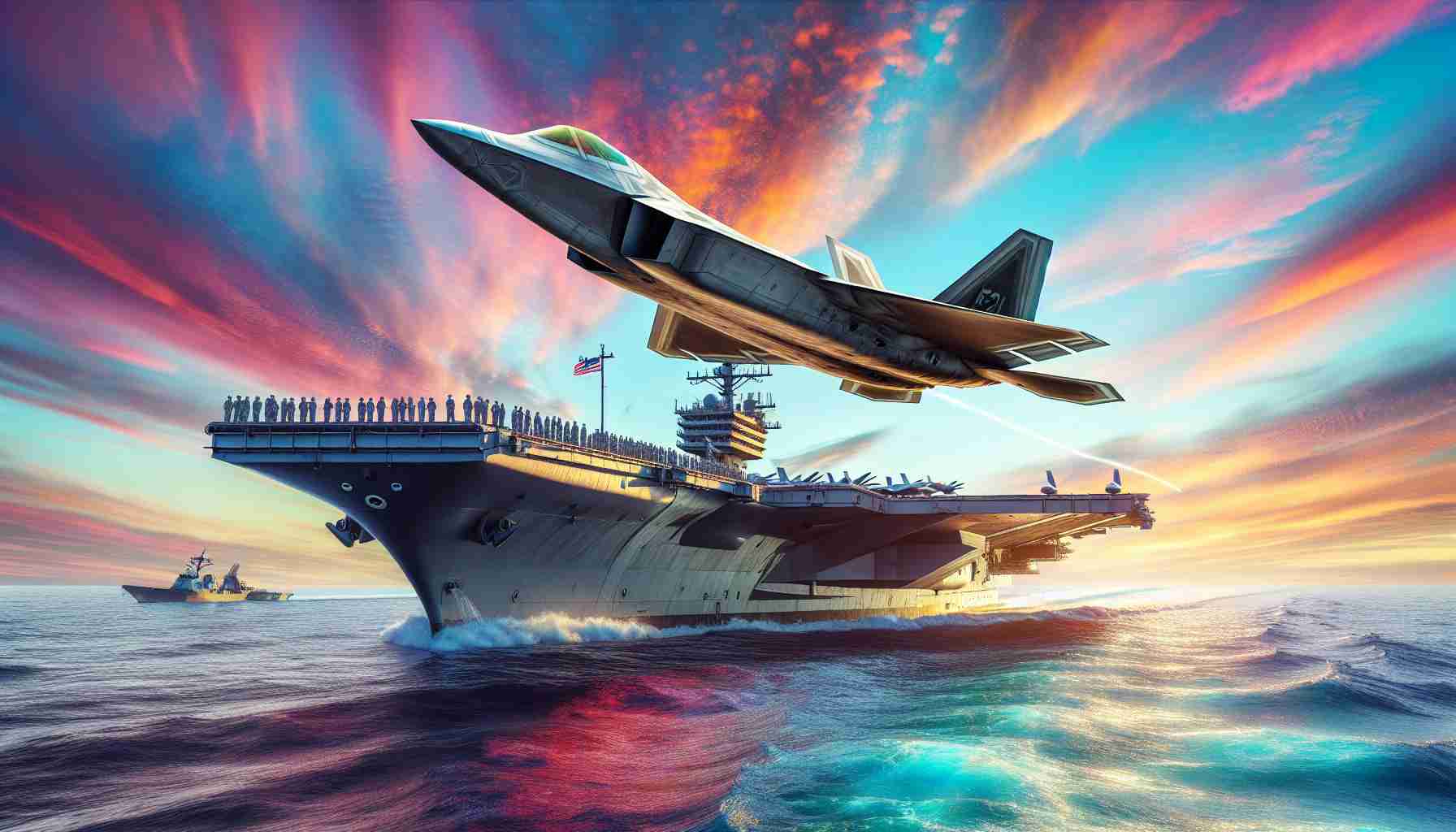Exploring the Untapped Potential of the F-22 Raptor for Naval Operations
The F-22 Raptor, celebrated for its ground-breaking stealth and agility, was once envisioned as a naval powerhouse called the “Sea Raptor.” If this concept had materialized, it would have transformed modern naval aviation, potentially outpacing the later F-35C in service.
Conceiving the Sea Raptor required substantial modifications. Engineers would have needed to reinforce the fuselage to withstand the force of carrier launches while redesigning the wings for safe landings. These changes raised concerns about diminishing the Raptor’s stealth capabilities. Despite having valuable data from the F-22’s performance with the Air Force, the military ultimately opted for the F-35C, with its robust fuselage and foldable wings—ideal for carrier operations, albeit coming with extensive delays and skyrocketing costs.
Had the Sea Raptor been developed, it could have replaced the aging F/A-18s, injecting fresh stealth technology into the U.S. Navy’s arsenal. The modifications necessary for carrier operations weren’t insurmountable, yet the U.S. military’s decision leaned towards a more complex route with the F-35C.
As global air threats evolve, the navy now benefits from the F-35C and is advancing next-gen projects like the F/A-XX. While the F-22 might have provided an earlier stealth presence on carriers, the focus on the F-35C reshaped naval air power for years to come.
Implications of the F-22 Raptor’s Naval Role
The discussion surrounding the F-22 Raptor’s potential as a naval asset extends beyond the confines of military specification; it highlights significant shifts in global defense strategy and technological innovation. As nations face increasingly complex air threats, the integration of stealth capabilities into carrier-based aircraft is no longer a luxury but a necessity. Had the Raptor transitioned to naval operations, it would have accelerated the U.S. Navy’s adaptability to evolving warfare dynamics, thus enhancing deterrence capabilities against peer competitors.
From a cultural standpoint, the idea of the “Sea Raptor” challenges traditional notions of naval aviation. The juxtaposition of land and sea capabilities within a single airframe could have fostered greater integration among military branches, promoting a unified approach to defense in a multipolar world. This shift in military ideology may have had long-lasting effects on recruitment, branch identity, and operational synergy.
Economically, investing in an F-22 naval variant would have implications for defense spending. The decision to pursue the F-35C, despite its cost overruns and delays, reflects a broader trend toward prioritizing joint capability over specialized solutions. Ultimately, this choice shapes not just U.S. military expenditure but also influences international arms sales and defense partnerships—especially with allies seeking advanced naval systems.
Looking ahead, the advancements in stealth technology and air superiority signify a pivotal moment for future naval operations. Programs like the F/A-XX represent a paradigm shift that could redefine carrier-based warfare. As nations prioritize technological supremacy, the echoes of the Raptor’s untapped potential will linger, challenging strategic planners to reconsider their options in safeguarding maritime interests.
The F-22 Raptor: Missed Opportunities and Future Innovations in Naval Aviation
Exploring the Untapped Potential of the F-22 Raptor for Naval Operations
The F-22 Raptor has become synonymous with advanced stealth and aerial dominance, yet an intriguing chapter in its history remains largely unexplored: its potential as a naval fighter known as the “Sea Raptor.” While this concept was ultimately set aside in favor of the F-35C, revisiting the idea reveals significant insights into naval aviation, military strategy, and future innovations.
# Features and Specifications of the F-22 Raptor
The F-22 boasts several unique features that could have been tailored for naval operations. With a top speed exceeding Mach 2, advanced avionics, and unmatched maneuverability, the Raptor was designed to achieve air superiority. If modified for carrier operations, engineers would have had to enhance structural integrity for catapult launches and tail hooks for landings—essential adaptations that pose both challenges and opportunities.
| Feature | F-22 Raptor | Potential Modifications for Sea Raptor |
|————————|———————–|———————————————–|
| Top Speed | Over Mach 2.0 | Reinforced fuselage for catapult launches |
| Stealth Technology | YES | Possible redesign impacts on stealth |
| Maneuverability | Superior | Enhanced landing gear and tail hook design |
| Avionics | Advanced | Optimized for naval operational environments |
# Pros and Cons of Developing the Sea Raptor
Pros:
– Enhanced Stealth Capability: Introducing the Raptor’s stealth features to naval operations would significantly improve the U.S. Navy’s air defense against evolving threat vectors.
– Replacement for Aging Fleet: The Sea Raptor could have been a direct replacement for the F/A-18s, allowing for a more stealthy and technologically advanced fighter platform.
Cons:
– Challenges to Stealth Integrity: Modifications for carrier operations might compromise the aircraft’s signature, limiting the benefits of its advanced design.
– Cost and Development Time: Undertaking substantial redesigns would likely lead to delays and increased costs, similar to the delays seen with the F-35C program.
# Current Naval Aviation Landscape and Next-Gen Projects
Today, the U.S. Navy counts on the F-35C for carrier operations, currently considered the backbone of naval air combat. However, with the advent of the F/A-XX program, new innovations may reshape how the Navy approaches aerial warfare in the future. The F/A-XX aims to further enhance stealth features and employ unmanned systems, acting as a next-generation solution to emerging threats.
# Compatibility and Innovations
The integration of the F-35C alongside next-gen fighter programs highlights a significant pivot in naval aviation strategy, focusing on:
– Unmanned Aerial Systems (UAS): The incorporation of UAS in naval operations presents opportunities for enhanced reconnaissance and strike capabilities.
– Network-Centric Warfare: Investment in advanced data-sharing systems improves situational awareness and allows for coordinated multi-platform strategies.
# Market Analysis and Future Predictions
Understanding the market dynamics of military aviation reveals that stealth technology, like that of the F-22, will continue to drive warfighter capabilities. As global threats evolve, the market’s focus on agility, stealth, and cost-effectiveness will likely lead to innovations that surpass even the F-22’s initial design parameters. Analysts predict a trend toward advanced fighter jets that will integrate cutting-edge technologies such as artificial intelligence and increased networking capabilities.
# Conclusion: Lessons from the Sea Raptor Concept
The concept of the Sea Raptor serves as a fascinating lesson in military strategy, illustrating both opportunities missed and paths taken. As the U.S. Navy continues to innovate and adapt to new challenges, the foundational work laid by platforms like the F-22 will likely inform the next generation of naval aviation. The balance between stealth, cost, and operational capability remains critical to maintaining superiority in the ever-evolving landscape of airborne threats.
For more insights into military aviation developments, visit Defense.gov.















